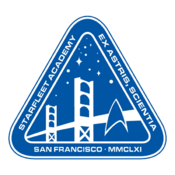Stellar Cartography: Difference between revisions
No edit summary |
mNo edit summary |
||
| Line 1: | Line 1: | ||
{{academy}} | {{academy}} | ||
The mapping of the cosmos is called '''Stellar Cartography'''. | |||
==Terminology== | ==Terminology== | ||
| Line 42: | Line 43: | ||
===Dominion space=== | ===Dominion space=== | ||
*[[List of Dominion planets]] | *[[List of Dominion planets]] | ||
[[Category:Stellar Cartograhpy]] | [[Category:Stellar Cartograhpy]] | ||
[[Category:Science]] | [[Category:Science]] | ||
Revision as of 22:50, 18 March 2005
| Academy Library |
|---|

|
|---|
 |
The mapping of the cosmos is called Stellar Cartography.
Terminology
Quadrants
Our galaxy is divided into four quadrants, defined by one meridian passing through the galactic core and the Sol System and a second one perpendicular to the first.
The United Federation of Planets and its neighbouring powers are located in the Alpha and Beta Quadrants. Sometimes, smaller sections of the galaxy are referred to as a quadrant, too. This terminology was most widely used in the 23rd Century, although some of these references still exist in the 24th Century. One example of this usage is the Morgana Quadrant.
Sectors
A sector is a much smaller, cubical volume of space. Sectors typically contain several stars and are consecutively numbered; some also have a label, normally, but not always, named after an important star system in that sector.
- According to the Star Trek: The Next Generation Technical Manual and the Star Trek Star Charts, a sector is 20x20x20 light-years in size. This, however, is not entirely consistent with all on-screen data.
Stellar Charts
General
- List of inhabited planets
- List of uninhabited planets
- List of homeworlds
- List of astronomical objects
- List of stars and stellar bodies